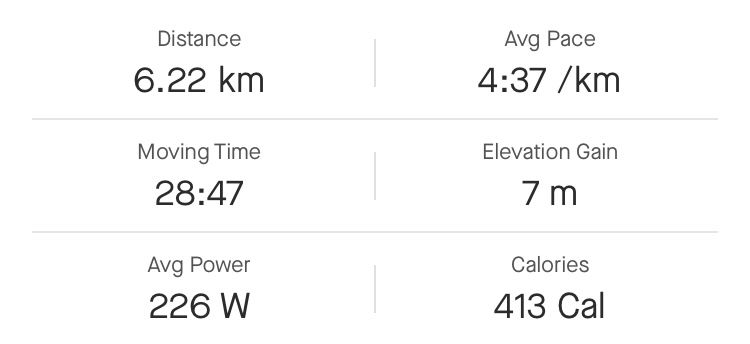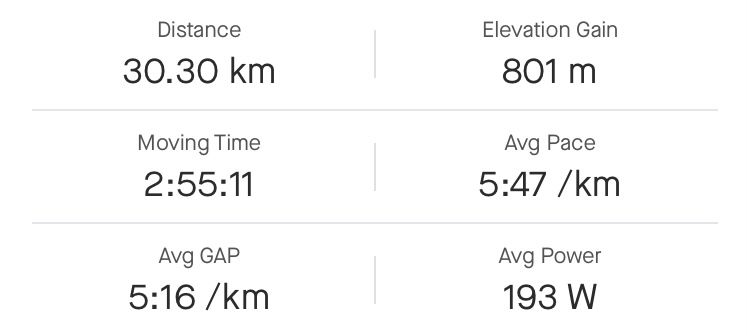Wrist based running power
-
My suunto vertical gives me this data I have never had this before. Iam familar with how power works in cycling. How is the watch calculating this? Gps, altimeter and maybe accelerometer?
My question is for my use mostly going uphill vertical kilometre I use my hands in my quads to push when going uphill to generate more power (poor man’s version of poles) would this cause incorrect run power considering my arm is not swinging instead it’s mostly pushing into my quads?
-
@gone-troppo cycling power is much easier, you are only connected in one place to the bike and apply all your force to the pedals, so measuring power output is “easy”. With running power it is an indirect measure based on acceleration, speed, ascent, descent etc. and some algorithm to estimate your power output
-
Thought I would provide an update on this after some more testing. Firstly the running power seems to be consistent per activity. Ie I get consistent results when going up a vertical kilometre between sessions.
Unfortunately it is not the same as flat road run. Flat road running gives much higher running power despite being in low hr zone compared to threshold effort going up hill. Ie an easy road run high zone 1 low zone 2 will produce 260 watts for me. A zone 4 uphill effort will produce only about 215 watts.
This makes it ok to compare per activity but it stuffs the power zones up in suunto app cos the ftp is way different for flat run to uphill according to results. So if I set my ftp for uphill all my flat run will be zone 5 for power. And if I set my ftp for flat run all my uphill will be low zone power
-
@gone-troppo said in Wrist based running power:
Flat road running gives much higher running power despite being in low hr zone compared to threshold effort going up hill. Ie an easy road run high zone 1 low zone 2 will produce 260 watts for me. A zone 4 uphill effort will produce only about 215 watts.
Yeah, I have found similar results to you @gone-troppo. For example here’s a flat, shorter road Z1/Z2 session I did last week

You can compare that to a longer hill session I did at the weekend where it was at a slightly higher intensity overall, Z2/Z3. But despite that the average power is over 30 watts less


It’s interesting, guessing I’ll get more accustomed to the nuances of running power over time as I garner more data
-
@MiniForklift how about NP? (normalized power) for terrains that have more variation in terms of altitude, NP should account for that extra effort vs compared to a flat terrain.
Also avg power looks OK to be lower in your second workout, even though it has more hills, you were moving up slower.
NP is likely to be higher in the session with hills.
But note higher in relation to avg in same session only. -
@gone-troppo
I am no expert but it is important to realize that running power and it’s relation to HR and effort is much more complex. It’s not the one magical number you can watch without any understanding (as companies often want it to sell). Even when you watch some Stryd webinars (or maybe some other relevant sources) you will find out that your a actual FTP and zones are not fixed and they will change according to other variables like terrain and length of an exercise. That means that for sure your FTP is different going into steep uphill because your running economy is different compared to running on flats. And you have another limitations than your heart rate, for example your muscles which can tire so even if your perceived effort is really high you are unable to put out so much power as on the flats - or only for a shorter time. And that doesn’t even consider technical terrain for example where the running power is sometimes useless.
So my advice is: use running power, it’s a great tool but use it for the occasions where it makes sense. For other occasions use another tools like HR or RPE. Everything has it’s place in training and nothing (except your brain:)) is perfect. -
@MiniForklift the average power is smaller because you were slower.
-
@gone-troppo IMHO and in Jason Koop’s opinion as well as others running power is not useful for trail running either uphill or downhill or flat. Power cannot take into account whether the terrain is technical or not, sand, roots, rocks, etc. Power cannot account for eccentric muscle contraction effort on steep downhills.
I do not use power for trail running except for interval training where I usually use a wide trail with a fairly smooth surface (dirt road) for uphill/downhill and flat intervals. -
@Brad_Olwin with Stryd that’s work very well but not with the power include on SV.
The algorithm doesn’t take into account the ascent and descents. Hope that will change soon…